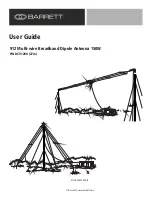
10
StarBand
®
Field Service & Maintenance Bulletins
StarBand
®
Field Service & Maintenance Bulletins
©2004-2013,
Caution
Do not use a DigiSat II meter to measure the RF-Out voltage. The DigiSat
II is only rated to 18 V DC and will be damaged by the greater voltages that are present
on this connector.
Test for ODU Input Short
With the transmit IFL cable removed from the ODU Type F connector, set the
multimeter to measure resistance in ohms and measure the resistance from the center
conductor of the ODU to the outer shield. This should be an
open
, with the multimeter
display showing
OL
(for OverLoad, meaning too high of a resistance to measure). If the
display shows a low resistance value (i.e., less than one ohm), there is a short in the
ODU. It has failed and must be replaced according to StarBand
®
Maintenance Bulletin
MB-0002.
Caution
Since it may be difficult to connect the multimeter red probe to the Type
F/female connector center conductor, install a Type F/male-male connector adapter
on the Type F/female connector, to measure the DC voltage.
Co-pol / Cross-pol Test
To perform a co-pol/cross-pol check, the satellite modem must have the
CON/ON-LINE
,
SYN
and
Rx
LEDs illuminated and the transmit IFL connecting the
ODU and satellite modem, in its normal configuration.
Call CVACS and select the option to request a co-pol and cross-pol check of the VSAT.
Possible results and what each indicates are as follows:
• If both co-pol and cross-pol measurements are within specifications, terminate the
test and power cycle the satellite modem, while viewing the LEDs. The modem
LEDs will go through two self-test sequences, then the
Rx
and
SYN
LEDs will come
on. Watch for the
Tx
LED to flash once or twice. If the
Tx
LED flashed, but the
VSAT did not
link connect
with the Hub, then the most likely problem is an incorrect
parameter value. The site parameters (VSAT ID, cluster, and subcluster) should be
re-checked. It is also possible, though less likely, that the ODU has a failure, which
could not be detected in the co-pol/cross-pol tests. If the
Tx
LED did not flash, then
the satellite modem is most likely the source of the problem and should be replaced.
• If the satellite modem LEDs started flashing when the test was attempted, but the test
could not be conducted, there is probably a short in the transmit IFL or in the ODU.
Recheck the IFL and ODU for shorts, with the multimeter (see FSB SB-0020).
• If the co-pol was low and the cross-pol was high (both out-of-spec), the problem
is most likely an antenna pointing problem (see FSB SB-0019).
• If the co-pol was low (out-of-spec) and the cross-pol was in-spec, then the ODU
has most likely failed and should be replaced (see MB-0002).











































